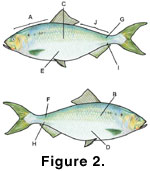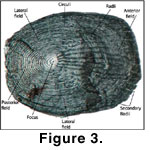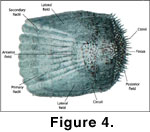SCALE CHARACTERISTICS
Most fish have a covering of scales, which can be divided into a variety of
types, over the outer surface of their bodies. These types include the
plate-like placoid scales of sharks; the diamond-shaped ganoid scales of the
gars; the thin, smooth, disk-like cycloid scales of most freshwater fish and
many marine species; and the ctenoid scales (with ctenii—small projections
along the posterior margins) of perches and sunfish (Casteel,
1976). All the species presented in this atlas are referable to the cycloid
and ctenoid types. Distinguishable scale characteristics include (1) overall
scale shape; (2) position and shape of focus; (3) circuli appearance; (4) the
appearance of the lateral, anterior, and posterior fields; and (5) to some
extent, thickness/robustness of the scale.
 As
there is considerable variation in scale shape even between different areas of
the same individual fish (Figure 2), scale outline is not always the best indicator for
identification (Chikuni, 1968; Casteel,
1972). Size
is also generally not a desirable characteristic, as scale size varies and
overlap occurs not only between species and individuals, but also within a
single specimen. Cycloid (Figure 3) and
ctenoid (Figure 4) scales show
considerable variation in their forms, although not always at either the genus
or species level, permitting their use for identification purposes.
As
there is considerable variation in scale shape even between different areas of
the same individual fish (Figure 2), scale outline is not always the best indicator for
identification (Chikuni, 1968; Casteel,
1972). Size
is also generally not a desirable characteristic, as scale size varies and
overlap occurs not only between species and individuals, but also within a
single specimen. Cycloid (Figure 3) and
ctenoid (Figure 4) scales show
considerable variation in their forms, although not always at either the genus
or species level, permitting their use for identification purposes.  The Salmonidae and, to a lesser extent, the Pleuronectidae, display particularly
consistent morphological characters. At this time identification of preserved
scales to higher taxonomic levels (e.g., Family) is straightforward providing
that an adequate comparative reference collection is available. While species
idenfication is possible for some genera, due to the lack of distinguishing
characteristics, species-level assignments for many groups are not possible.
The Salmonidae and, to a lesser extent, the Pleuronectidae, display particularly
consistent morphological characters. At this time identification of preserved
scales to higher taxonomic levels (e.g., Family) is straightforward providing
that an adequate comparative reference collection is available. While species
idenfication is possible for some genera, due to the lack of distinguishing
characteristics, species-level assignments for many groups are not possible.
The terminology used to describe scales usually refers to topographical
features such as surface sculpturing or internal variations (Figure
3, Figure 4). Lagler
(1947) established the terminology utilized here to describe various scale
features as follows:
 'Circuli'
are defined as elevated markings on the surface, usually appearing as lines
that more or less follow the outline of the scale.
'Circuli'
are defined as elevated markings on the surface, usually appearing as lines
that more or less follow the outline of the scale.- 'Focus' refers to the first part, often central,
of the scale to appear in growth.
- 'Radii' are grooves that radiate from the focus
to the scale margins.
- 'Primary Radii' are radii that extend from the
focus to margin.
- 'Secondary Radii' are radii that begin outward
from, not at, the focus.
- 'Ctenii' are toothlike structures on the
posterior portion of some scales.
- 'Fields' are areas of the outer surface of the
scale, either real as delimited by angulations of the circuli, or implied if
the configuration of the circulii are otherwise. Various adjectives applied
to fields are based on their position in relation to the orientation of the
scale on a living fish.
- 'Anterior Field' is bounded by imaginary lines
connecting the anterolateral corners (dorsal and ventral) or their
equivalent points on rounded scales.
- 'Posterior Field' is bounded by imaginary lines
connecting the posterolateral corners (dorsal and ventral) with the focus.
- 'Lateral Fields' are the dorsal and ventral
fields remaining after delimination of the anterior and posterior fields.

 As
there is considerable variation in scale shape even between different areas of
the same individual fish (Figure 2), scale outline is not always the best indicator for
identification (Chikuni, 1968; Casteel,
1972). Size
is also generally not a desirable characteristic, as scale size varies and
overlap occurs not only between species and individuals, but also within a
single specimen. Cycloid (Figure 3) and
ctenoid (Figure 4) scales show
considerable variation in their forms, although not always at either the genus
or species level, permitting their use for identification purposes.
As
there is considerable variation in scale shape even between different areas of
the same individual fish (Figure 2), scale outline is not always the best indicator for
identification (Chikuni, 1968; Casteel,
1972). Size
is also generally not a desirable characteristic, as scale size varies and
overlap occurs not only between species and individuals, but also within a
single specimen. Cycloid (Figure 3) and
ctenoid (Figure 4) scales show
considerable variation in their forms, although not always at either the genus
or species level, permitting their use for identification purposes.  The Salmonidae and, to a lesser extent, the Pleuronectidae, display particularly
consistent morphological characters. At this time identification of preserved
scales to higher taxonomic levels (e.g., Family) is straightforward providing
that an adequate comparative reference collection is available. While species
idenfication is possible for some genera, due to the lack of distinguishing
characteristics, species-level assignments for many groups are not possible.
The Salmonidae and, to a lesser extent, the Pleuronectidae, display particularly
consistent morphological characters. At this time identification of preserved
scales to higher taxonomic levels (e.g., Family) is straightforward providing
that an adequate comparative reference collection is available. While species
idenfication is possible for some genera, due to the lack of distinguishing
characteristics, species-level assignments for many groups are not possible.